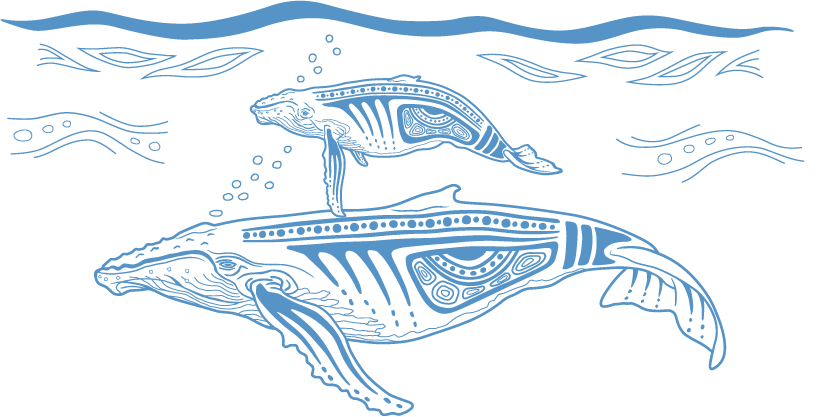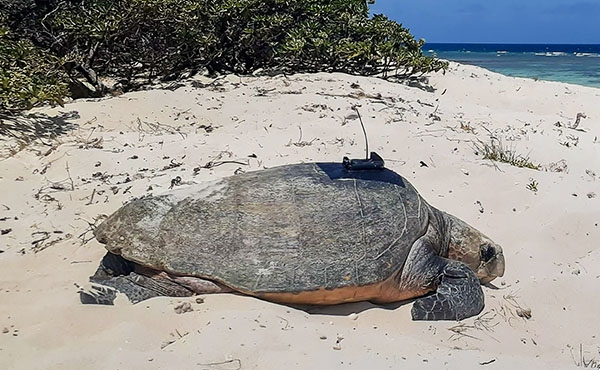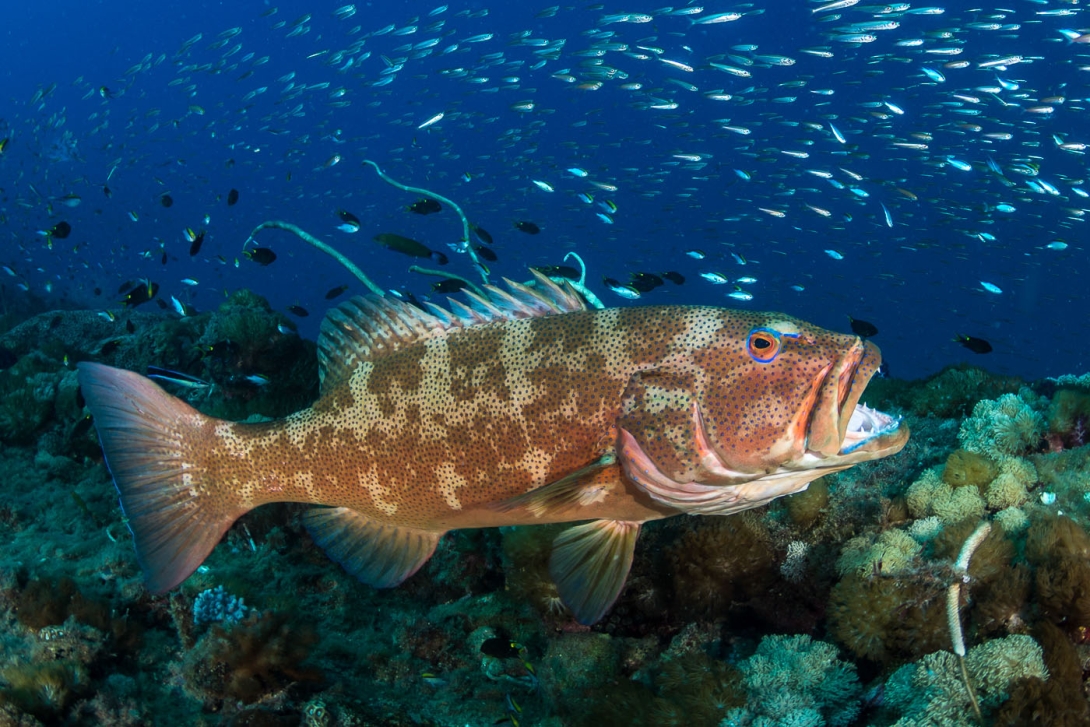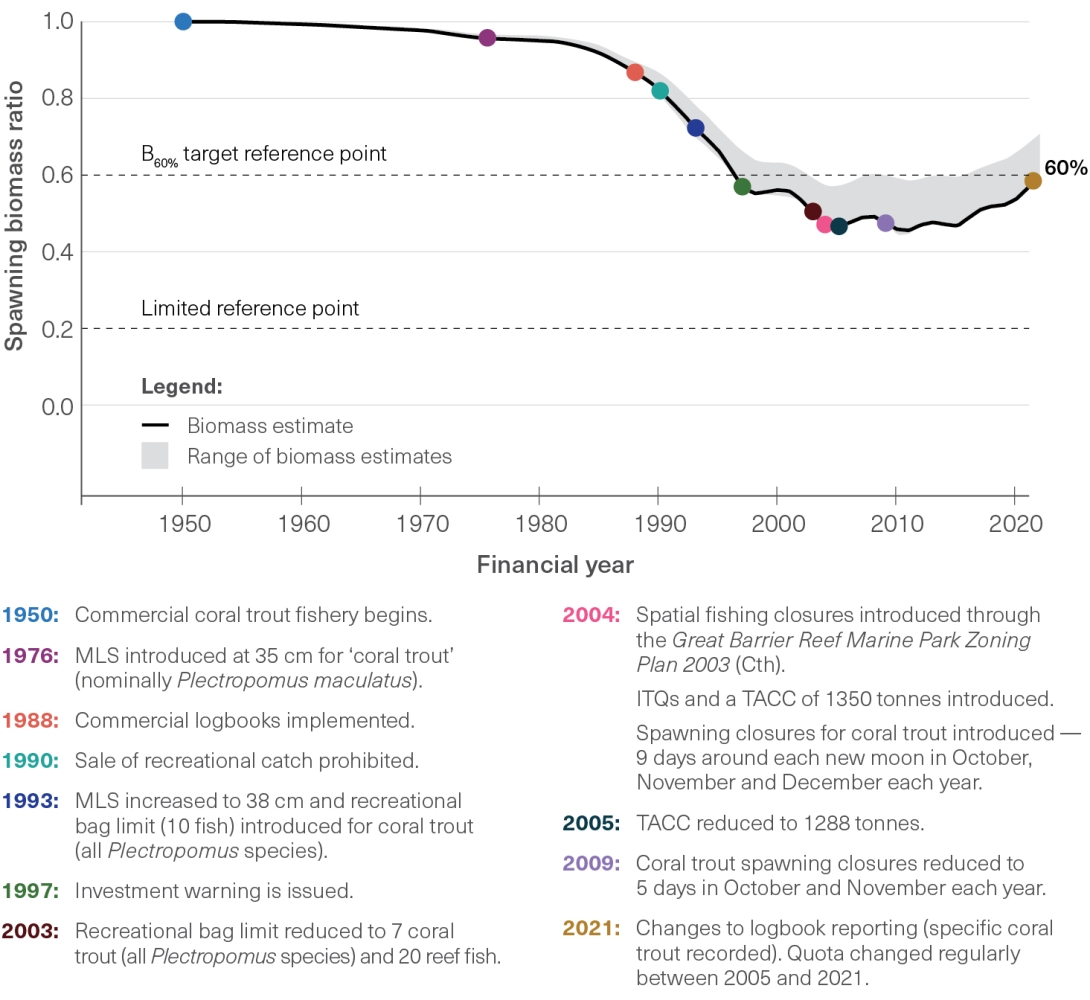Coral trout belong to the genus Plectropomus and are one of the largest and most conspicuous fishes on coral reefs of the Indo-Pacific. They are key reef predators that play an important role in the transfer of energy through the food chain and influence the composition of fish assemblages through top-down control via predation.1331,2077 Coral trout are also highly prized food fishes that are targeted by commercial, recreational, artisanal and subsistence fisheries throughout their geographic ranges.2078,2079 Coral trout is one of the major components of the line fishery catch in the Reef. The genus Plectropomus has 8 species, of which 6 occur in the Region.2080
Common coral trout (Plectropomus leopardus) is the most abundant and widespread coral trout species across most of the Region.2081 Two closely related species, the spotted (bar-cheek) coral trout (Plectropomus maculatus), and the black-saddled (footballer/blue-spot) coral trout (Plectropomus laevis) are common on inner-shelf and outer-shelf reefs, respectively.2081,2082 Common coral trout typically have constrained home ranges but can move considerable distances within and sometimes among reefs, particularly when transiting to and from spawning aggregation sites.2083,2084,2085
Common coral trout are protogynous hermaphrodites that transition from female to male throughout their development.2078 Females reach sexual maturity at 30 to 37 centimetres total length and 2 to 3 years of age.2086 The size and age of transition from female to male is variable but is likely to be influenced by a range of factors including population size structure, behavioural processes, and fishing intensity.2086 In the Region, peak spawning periods extend over several days around new moons spanning the Australian summer.2087 However, recent evidence also shows that the Reef’s coral trout can spawn and produce viable offspring throughout the year.1357 Hybridisation among several coral trout species is known to occur, including between common coral trout and spotted coral trout.2088,2089
Coral trout closely associate with coral reef habitat. Post-settlement juvenile coral trout are commonly found in patchy reef habitats with interspersed live coral colonies that provide them with shelter.2090 Adult coral trout often reside under tabular corals and within reef crevices that provide shade, shelter and concealment from which they can ambush prey.2091 Coral trout population dynamics and resilience can be strongly influenced by changes in coral cover, reef habitat complexity and prey abundance following disturbance events.2091,2092,2093 Therefore, coral loss can increase the risk of overfishing of coral trout stocks due to sudden productivity declines.2094 For example, on fringing reefs in the Keppel Islands group in the southern region, coral trout abundance was significantly reduced, and tracked the trajectory of declines in coral cover and prey fish abundance, following flood plume disturbances between 2009 and 2013.2092
A recent study has shown that physiological parameters used to assess the health of coral trout were unrelated to coral cover at sites where individual fish were captured. These results suggest that adult common coral trout may be resilient to declines in coral cover, at least over periods of 2 to 5 years following acute coral loss caused by climate-induced mass coral bleaching.2095 Given the age at first breeding for coral trout is 2 to 3 years and that adult biomass is dominated by older age classes, the impacts of reduced coral cover on adult biomass are unlikely to manifest for at least 5 years.2094 Additionally, past stock assessments for coral trout have not found any clear association between bleaching events and coral trout catchability. However, a previous stock assessment observed that coral loss caused by cyclones correlated with lower catchability of coral trout over the following years.2096 A lack of relationship between coral cover and the health of individual adult coral trout likely represents the coral trout’s increased access to prey resources and reduced investment in key energetic process, such as growth. These factors may increase the resilience of coral trout to habitat degradation in the short-term.2095
Pressures such as increases in sea temperature can directly affect fish physiology and behaviour, which can ultimately undermine the capacity of coral trout populations to acclimatise or adapt to changes in environmental conditions.2097 Loss of coral and habitat degradation are also factors influencing coral trout biology and ecology.




